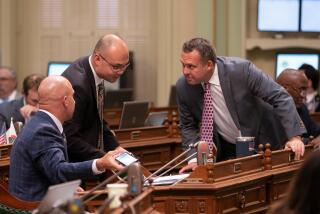Official’s Tax Break: on Firm Ground?
- Share via
When U.S. Rep. Gary Miller (R-Diamond Bar) sold 165 acres to the city of Monrovia in 2002, he made a profit of more than $10 million, according to a financial disclosure form he filed in Congress. Ordinarily, he would have had to pay state and federal taxes of up to 31% on that profit.
Instead, Miller told the Internal Revenue Service and the state that Monrovia had forced him to sell the property under threat of eminent domain. That allowed him to shelter the profits from capital gains taxes for more than two years before he had to reinvest the money.
But there is a problem with Miller’s claim: Monrovia officials say that Miller sold the land willingly and that they didn’t threaten to force him to sell.
Miller, whose 42nd Congressional District includes chunks of Los Angeles, Orange and San Bernardino counties, claimed the same exemption in two subsequent Fontana property transactions, allowing him to continue sheltering his profits from the Monrovia sale. And in each of those cases, the purchasers say eminent domain, which allows a government agency to force a sale if it’s in the public interest, was neither used nor threatened.
Internal Revenue Code Section 1033 was designed to protect people whose land is condemned by government agencies or destroyed in natural disasters. Other investors wishing to postpone capital gains taxes would have to follow complicated rules that include reinvesting the entire amount in other property within 180 days. For Miller, a millionaire land developer in the Inland Empire and a senior member of the House Transportation and Infrastructure Committee, repeated use of the forced-sale exemption has enabled deferment of capital gains taxes through at least 2009.
Miller declined to comment on the sales after officials in Monrovia disputed his eminent domain contention. Officials with the IRS and the state Franchise Tax Board said it’s not their policy to comment on individual cases.
In an earlier interview, Miller described being threatened by Monrovia during the bargaining process and said the city gave him no choice but to sell. He said that he prided himself on transparency and noted that he fully disclosed all of his property transactions.
“The base of the deal was either you sell to us or we’ll have to condemn it,” Miller said.
But records and interviews in Monrovia show that the sale of Miller’s land was voluntary.
Glen Owens, a member of Monrovia’s Planning Commission, said the city could not have used eminent domain to purchase Miller’s property, because it was acquiring the undeveloped hillside land for a wilderness preserve using state funding that specifically prohibited forced sales.
“The state doesn’t go along with eminent domain,” he said. “You have to have a willing seller.”
A letter from then-City Manager Don Hopper at the time of the sale confirms that use of state funds blocked the city from considering eminent domain.
“Under the guidelines of the Challenge Grant Program, all property owners must be willing sellers,” Hopper wrote in May 2002.
A videotape of a February 2000 City Council meeting, packed with people pushing the city to protect the hillside, shows Miller pleading with city officials four times to buy his land.
“Why don’t you buy my property? I’ve asked you repeatedly,” Miller said.
Miller’s press secretary, Kevin McKee, wrote in an e-mail to The Times, “Mr. Miller and the city of Monrovia agreed upon the purchase price and a friendly condemnation.”
Although early drafts of Monrovia’s sales contract with Miller included the phrase “friendly condemnation,” it was stricken when the final deal was made. Miller and his wife signed an amendment to the escrow instructions on Aug. 1, 2002, saying, “condemnation deleted.”
Scott Ochoa, the assistant city manager at the time and now the city manager, said the city always discusses the possibility of so-called “friendly condemnation” when it is negotiating a purchase in case a seller wants to claim the forced-sale exemption. In this case, though, the state funds took that option off the table, he said.
Miller said that two years after the Monrovia sale, he raced to beat his extended deadline of Dec. 31, 2004, for reinvesting the profits. On Dec. 28, he reinvested some of the profits by purchasing 10 lots for about $5 million near the expanded 210 Freeway in Fontana, a building in Fontana for $1.3 million and five acres in Rancho Cucamonga worth about $2 million. He bought the properties from Lewis Operating Corp., a major Inland Empire developer and one of Miller’s largest campaign contributors.
Miller took an exemption again when he sold the 10 lots to the city of Fontana in 2005 and again when he sold the building to Fontana this year, claiming both were compulsory sales. Those moves gave him at least another two years after each sale to reinvest the funds without paying capital gains taxes.
But records and interviews in Fontana show that those sales were not compulsory.
“From my perspective, if we were ever asked, I would say we were not threatening eminent domain,” said Clark Alsop, the lead lawyer representing Fontana.
In fact, Miller bought the properties knowing that Fontana would be purchasing them.
“The market kept going through the roof, as you know, and I was running out of options,” Miller said. “Lewis had bought some property at the request of Fontana. I thought, ‘That’s safe. I’ll buy it. They’ll buy it a year from now, and that’s no big deal.’ ”
Such a sale could have meant that Miller would finally be liable for the capital gains taxes he had deferred by purchasing the Fontana property.
But when Miller sold the 10 lots, most of them with homes, to the Fontana redevelopment agency in April and June 2005 for about $5 million, he filed a tax withholding form for the sale and claimed an exemption by checking a box that said that the sale was “being compulsorily or involuntarily converted” and that he intended to acquire a similar property with the money “to qualify for nonrecognition of gain.”
To bolster his case that the sale was forced, Miller also asked the city for “a letter that talked about eminent domain,” said Ray Bragg, the city’s redevelopment director.
Bragg called it “a courtesy letter. Agencies do it when asked.”
The March 22, 2005, letter, signed by City Manager Kenneth R. Hunt, does not threaten to take Miller’s land. In fact, it notes that the “redevelopment plan for this project area does not currently authorize the use of eminent domain.” But it also notes that, “the Redevelopment Agency is in the process of amending the redevelopment plan to authorize the use of eminent domain.”
Bragg said that as far as the city is concerned, the letter does not threaten the use of eminent domain.
“It’s really between him and his tax man and the IRS as to whether what is said in that letter is valid to say that the city was going to condemn the property,” Bragg said.
Fontana attorney Alsop said he had not been consulted about the letter.
“It’s pretty clear to me that the city cannot make a representation to the IRS that this is property being taken under the threat of eminent domain and therefore this person deserves a tax break,” Alsop said.
Another property owner in the area, Jesse Bojorquez, bought land the city had its eye on and ultimately sold it to Fontana’s redevelopment agency. He asked for the same kind of letter to support a claim for a forced-sale exemption.
Unlike the letter Miller was given, Bojorquez’s letter from Hunt contained a paragraph that explicitly stated it was not to be used as “a representation or warranty as to the applicability of the Internal Revenue Code Section 1033.
“I’m just a little guy,” Bojorquez said. “Why would they beat me up in my letter and not beat this guy up? It’s not fair.”
More than a year later, when Miller sold the Fontana building he had purchased from the Lewis Corp. to the city, he again filed a tax form invoking an exemption by claiming that the sale was compulsory. The city planned to use the structure as a temporary home for a branch of the county library.
Again, the city wrote Miller a letter noting that it had the power of eminent domain in its downtown redevelopment district but wasn’t planning to use it to acquire the library building. There was no need to. When Miller bought the building from the Lewis Corp., he assumed Lewis’ lease arrangement with Fontana that included an option for the city to buy the property outright.
“In reality, that letter is meaningless, and any IRS auditor who took a look at it would know that,” Bragg said.
By invoking Section 1033 again, though, Miller was able to defer the payment of a portion of the capital gains taxes from the Monrovia sale until at least 2009.
The property he bought in Rancho Cucamonga with some of the proceeds from the Monrovia sale hasn’t been sold.
Experts in eminent domain law said the arrangement between Fontana and Miller is pushing the legal envelope.
“Public use condemnation is meant to be a rarity because it’s such an extraordinary power,” said Doug Kmiec, a constitutional law professor at Pepperdine University. “And a taxpayer who has manipulated the process to provide evidence of a threat where none exists is not much different than a taxpayer who claims deductions on his tax return based on things he made up in his basement.”
Tax experts said Miller would have a tough time proving to an IRS auditor that he was forced to sell property three times in a row.
“You really shouldn’t be just happening into all these 1033 transactions unless you’re very unlucky,” said Washington, D.C., tax lawyer Brian Lynn, who has written about the tax exemption. “Multiple 1033 transactions might look fishy to an auditor. You have sort of the pattern-of-evidence problem.”
Heisel’s e-mail address is
More to Read
Inside the business of entertainment
The Wide Shot brings you news, analysis and insights on everything from streaming wars to production — and what it all means for the future.
You may occasionally receive promotional content from the Los Angeles Times.










